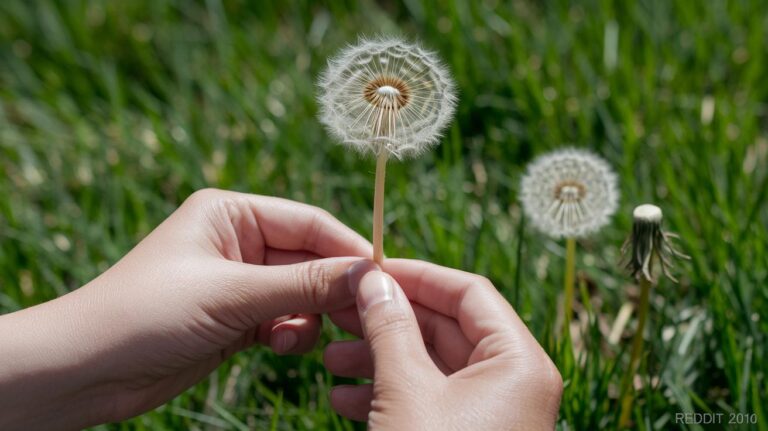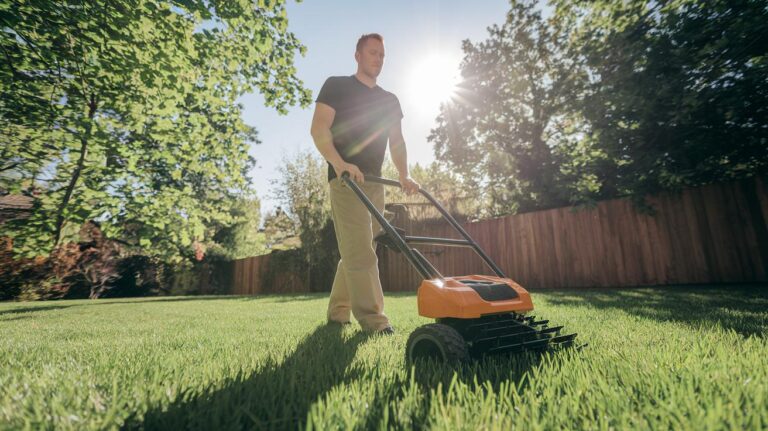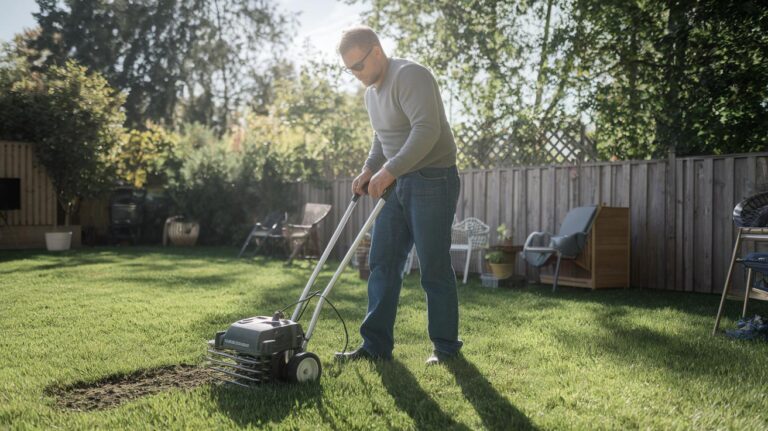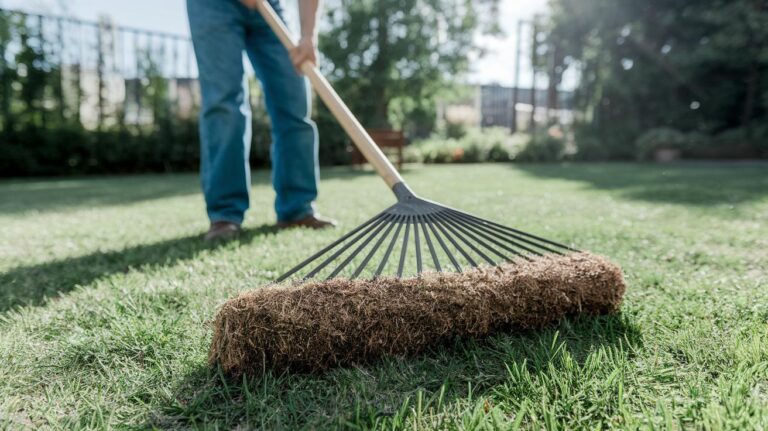Best Time For Lawn Aeration Ensures Thriving Turf
Ever poked your lawn with an aerator (that tool that makes tiny holes in the soil so air, water, and nutrients can slip down to the roots) and thought, uh-oh, am I making things worse? The grass can look like it’s gasping for life. But hang on, the secret really is all in the timing.
And if you wait until the soil and air are just right, those tiny holes can turn hard-packed grass into a soft, green carpet. Think of the ground like a sponge. You wet it, squeeze out extra water, then fluff it before you plant. Whether your grass thrives in the cool spring or the hot summer, nailing the timing for your area helps your yard bounce back fast.
Aeration Timing by Grass Type and Region
Warm-season grasses like Bermuda, Zoysia, centipede, St. Augustine, and Bahia need aeration (making tiny holes in the soil so air, water, and nutrients can reach the roots) when the soil temperature is around 65 to 75°F and the air is 80 to 95°F. That sweet spot usually shows up in late spring to early summer. Want a quick how-to? Check out What Is Lawn Aeration?. Then match those dates to your region below.
| Region | Months | Soil Temp Range |
|---|---|---|
| Southern | May to July | 65–75°F |
| Transition | May to July | 65–75°F |
| Northern | June to July | 65–75°F |
And don’t forget soil moisture. The ground should feel moist (not soggy) so tines (the prongs on your aerator) cut clean holes. Too dry and you’ll get crumbly bits. Too wet and you’ll wrestle with muddy plugs. Warm-season grasses bounce back fast when roots can sip water and nutrients. You’ll see the little plugs disappear in just days as grass fills in.
Cool-season grasses like Kentucky bluegrass, perennial rye, and tall fescue prefer aeration when soil temperatures sit between 50 and 65°F. That late summer to early fall window gives fresh seeds a head start before winter naps. If a screwdriver slides into the ground without much effort, you’ve hit your cue. Plan the best time for your lawn using the chart below.
| Region | Months | Soil Temp Range |
|---|---|---|
| Northern states | Mid-August to Mid-September | 50–65°F |
| Transition zones | Mid-August to Mid-October | 50–65°F |
| Deep South | October to Early December | 50–65°F |
Don’t wait for brown patches to show up. Proactive aeration pays off with a fuller, greener lawn. Just avoid aerating when frost is likely, during a summer heat wave, or in drought conditions, seeds can fail and roots suffer. If your late-fall soil isn’t frozen yet, give dormant seeding (planting seed before winter) a try so new grass pops up in early spring as the weather warms.
Detecting Soil Compaction and Thatch Before Lawn Aeration
Does your lawn feel firm underfoot instead of soft and springy? Or do you notice a matted layer of dead grass bits (thatch) thicker than ½", stopping water and air from reaching the roots? Heavy foot traffic and clay soil often squeeze moisture and oxygen right out of the ground.
You can check for problems with a few simple tests:
- Thatch (dead grass bits) over ½" blocking moisture and air
- Little puddles after a light rain, a sign of poor drainage
- A screwdriver or pencil that won’t push in easily, hinting at soil compaction (when dirt gets pressed too tightly)
Other hints your grass might show:
- Thin turf or bare spots
- Yellow or brown patches that refuse to green up
- Fertilizer sitting on top instead of soaking in
That’s when aeration (poking small holes in the soil) comes to the rescue. Pulling out tiny plugs lets air, water, and nutrients slip down to thirsty grassroots. Roots will grow deeper, thatch will break down faster, and your lawn will bounce back lush and even.
Have you ever seen those little soil plugs after aerating? They almost look like mini cookies. Oops, I meant tiny soil plugs, not cookies!
Core vs. Liquid Aeration: Methods and Timing Impact

Choosing how you aerate your yard shapes when you’ll work and how fast your grass bounces back. Core aeration (yanking out small plugs of compacted soil) and liquid aeration (spraying a wetting agent that helps water soak in) each bring perks. And each one shines at different seasons and grass types. Let’s break them down.
Core Aeration
This method pulls 2-3 inch plugs of compacted soil right out of your grass. Those little plugs, about the size of a quarter, give air, water, and starter seed (baby grass seed) a fast track to your roots. Have you ever felt warm earth crumble between your fingers? It’s pretty satisfying.
For a small yard, just press a garden fork into the ground every 4-6 inches instead of renting a big machine. Larger lawns? A powered walk-behind or tractor-mounted plug aerator gets it done in one pass. Skip spike aerators with solid tines, or they squeeze the soil around the holes and undo your hard work. Oops, trust me on this one.
Liquid Aeration
Liquid aeration uses a wetting agent, a liquid that loosens packed soil crumbs. This way, you skip the plugs and gently free up your ground. It’s perfect for fine grass or new seed when you don’t want holes. And you can do it when the ground’s too wet or too dry for core aerators.
Spray in early fall or late spring, then water lightly so the mix slips down to the roots and you’ll see results in weeks as the soil loosens and tiny roots push deeper. Choose liquid aeration if you need a gentle option or want to boost your next top-dressing (adding a thin layer of soil mix) without stumbling over plugs. By the way, my cat loves to nap on that soft, airy turf afterward. Happy aerating!
Post-Aeration Care: Overseeding, Fertilizing, and Watering
Right after aerating your lawn, seeds need to make direct contact with the soil to sprout. Spread grass seed over any thin or bare spots right away. For cool-season lawns, choose ryegrass or fescue seed in early fall so the seedlings settle in before frost.
Next, give your new grass a power snack with a starter fertilizer (plant food high in phosphorus, a nutrient that fuels root growth). Follow the package directions and gently work the granules into the topsoil. Think of it like feeding hungry roots so they can anchor fast.
Watering is key. Aim for about ¼ inch of water each day for two weeks, you can use a rain gauge or even an empty tuna can to measure. Once you spot tiny green shoots, cut back to three times a week and double the soak time. That trick teaches roots to grow deeper and stronger.
Hold off on mowing until grass reaches about 3 inches tall, usually a week after germination. Set your mower deck at 3 inches so the blades slice cleanly. A sharp blade is like a good knife, it won’t tear those tender shoots and helps the grass thicken evenly.
Finally, sprinkle on a light topdressing of compost (decayed organic matter that enriches soil). Rake on a thin dusting rather than dumping it on. Compost feeds the soil microbes (the tiny helpers) and holds moisture around new roots for steady growth.
Equipment Choices and Frequency for Lawn Aeration Success
Most lawns get aerated once a year. But if your yard’s clay-heavy (thick, sticky soil that holds water) or has stubborn bare spots, you’ll see big benefits from a second round. Need help picking the right time? Check How Often Lawn Aeration.
DIY fans have tools for every yard size. For a narrow strip, grab a garden fork (think of a big handheld pitchfork) and push its tines (the prong thingies) into the warm soil every 4 to 6 inches. You’ll hear a satisfying crunch as you pull up little plugs of earth.
Got up to two acres? Renting a core aerator (it pulls tiny soil plugs) from your local tool shop does the trick. And if you’re running a golf-course-level lawn, a tractor-mounted plug machine will chew through compaction in minutes. Pretty neat, right?
Hiring a pro usually runs about fifty to a hundred dollars a treatment. I like to scroll through local aeration service directories, compare prices, and lock in a slot when my grass looks thirsty for air. Pros bring sharp, rust-free tines and the know-how to match timing to your grass type.
By the way, don’t skip gear care or marking hidden obstacles. After each use, clean off grit and oil those tines so they stay biting sharp. Oops, you might forget this sometimes. Flag any buried sprinkler heads, cables, or garden hoses before you start, no one wants a surprise cable tug mid-run.
Common Mistakes to Avoid in Lawn Aeration Scheduling

Timing Tips
Timing it right makes all the difference. Let’s make sure you hit the sweet spot.
- Set a calendar reminder for your ideal aeration (poking holes in soil to let air, water, and nutrients reach grass roots) window – usually mid-October or early spring – so it doesn’t get buried under weekend chores.
- Check that the soil feels just moist, not soggy, before you fire up your aerator (the hole-punching machine). A screwdriver should slide in with little effort.
- Avoid heavy rain or muggy stretches. Wet weather can squash the holes you just made and even invite fungus, right?
- Use a soil thermometer to make sure the ground stays between 50°F and 65°F before you begin.
Final Words
You’ve got the cheat sheet for when and how to aerate different grass types. Feel the cool soil underfoot as you plan your work.
Southern warm-season lawns shine in May–July, cool-season grasses thrive from late summer to early fall.
You’ll spot thatch, choose core or liquid methods, and follow up with seeding and feeding.
Keep your tools sharp, watch the weather, and steer clear of heat spikes or frost threats.
Now’s the best time for lawn aeration, get ready for a lush, healthy turf your neighbors will envy.








2 Comments